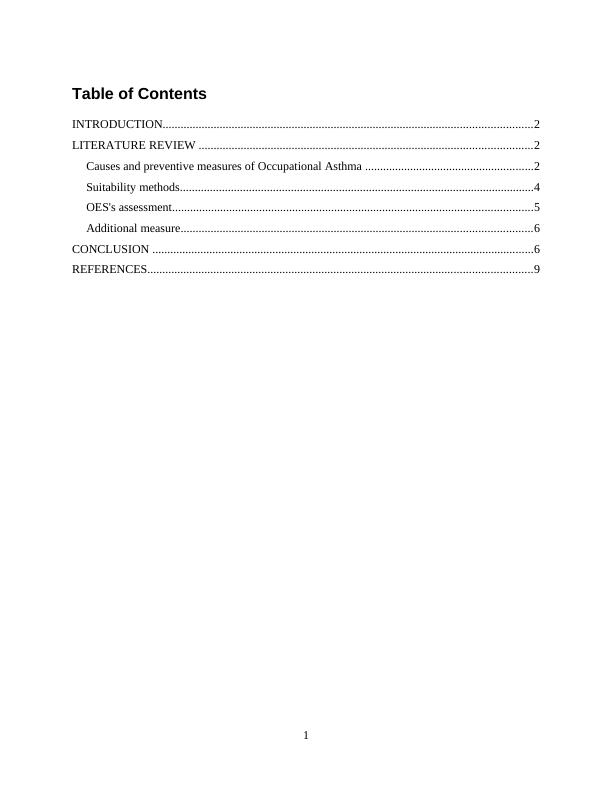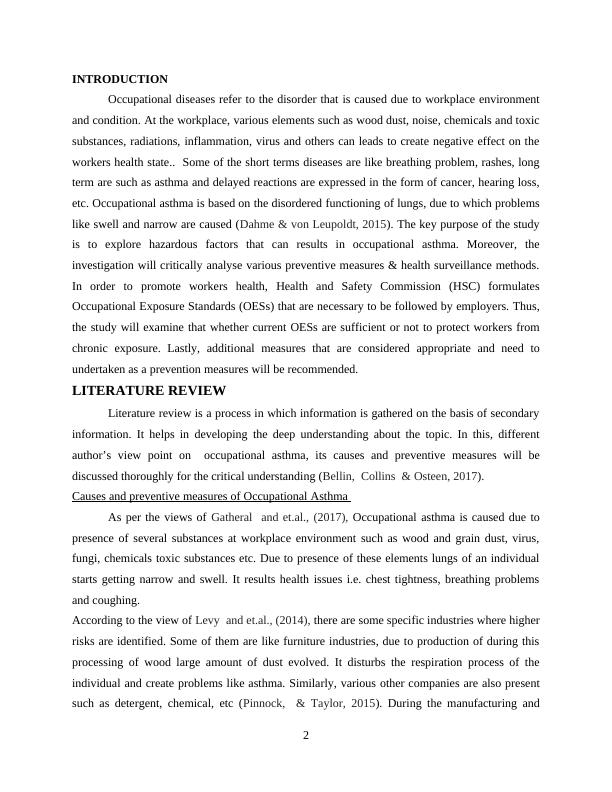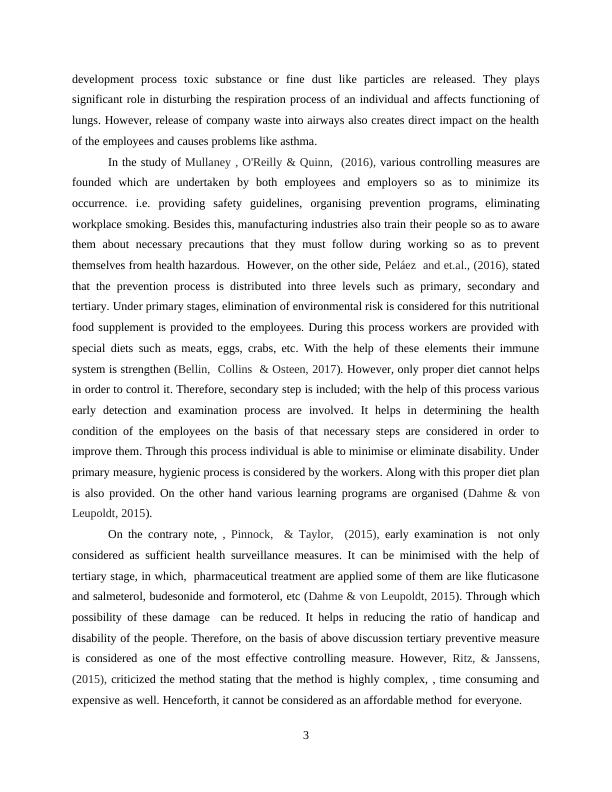Risk Assessment for Occupational Exposure Essay
11 Pages3593 Words63 Views
Added on 2020-06-04
Risk Assessment for Occupational Exposure Essay
Added on 2020-06-04
ShareRelated Documents
TOXICOLOGY ANDDISEASE REPORT

Table of ContentsINTRODUCTION...........................................................................................................................2LITERATURE REVIEW ...............................................................................................................2Causes and preventive measures of Occupational Asthma ........................................................2Suitability methods......................................................................................................................4OES's assessment........................................................................................................................5Additional measure.....................................................................................................................6CONCLUSION ...............................................................................................................................6REFERENCES................................................................................................................................91

INTRODUCTIONOccupational diseases refer to the disorder that is caused due to workplace environmentand condition. At the workplace, various elements such as wood dust, noise, chemicals and toxicsubstances, radiations, inflammation, virus and others can leads to create negative effect on theworkers health state.. Some of the short terms diseases are like breathing problem, rashes, longterm are such as asthma and delayed reactions are expressed in the form of cancer, hearing loss,etc. Occupational asthma is based on the disordered functioning of lungs, due to which problemslike swell and narrow are caused (Dahme & von Leupoldt, 2015). The key purpose of the studyis to explore hazardous factors that can results in occupational asthma. Moreover, theinvestigation will critically analyse various preventive measures & health surveillance methods.In order to promote workers health, Health and Safety Commission (HSC) formulatesOccupational Exposure Standards (OESs) that are necessary to be followed by employers. Thus,the study will examine that whether current OESs are sufficient or not to protect workers fromchronic exposure. Lastly, additional measures that are considered appropriate and need toundertaken as a prevention measures will be recommended. LITERATURE REVIEW Literature review is a process in which information is gathered on the basis of secondaryinformation. It helps in developing the deep understanding about the topic. In this, differentauthor’s view point on occupational asthma, its causes and preventive measures will bediscussed thoroughly for the critical understanding (Bellin, Collins & Osteen, 2017).Causes and preventive measures of Occupational Asthma As per the views of Gatheral and et.al., (2017), Occupational asthma is caused due topresence of several substances at workplace environment such as wood and grain dust, virus,fungi, chemicals toxic substances etc. Due to presence of these elements lungs of an individualstarts getting narrow and swell. It results health issues i.e. chest tightness, breathing problemsand coughing. According to the view of Levy and et.al., (2014), there are some specific industries where higherrisks are identified. Some of them are like furniture industries, due to production of during thisprocessing of wood large amount of dust evolved. It disturbs the respiration process of theindividual and create problems like asthma. Similarly, various other companies are also presentsuch as detergent, chemical, etc (Pinnock, & Taylor, 2015). During the manufacturing and2

development process toxic substance or fine dust like particles are released. They playssignificant role in disturbing the respiration process of an individual and affects functioning oflungs. However, release of company waste into airways also creates direct impact on the healthof the employees and causes problems like asthma. In the study of Mullaney , O'Reilly & Quinn, (2016), various controlling measures arefounded which are undertaken by both employees and employers so as to minimize itsoccurrence. i.e. providing safety guidelines, organising prevention programs, eliminatingworkplace smoking. Besides this, manufacturing industries also train their people so as to awarethem about necessary precautions that they must follow during working so as to preventthemselves from health hazardous. However, on the other side, Peláez and et.al., (2016), statedthat the prevention process is distributed into three levels such as primary, secondary andtertiary. Under primary stages, elimination of environmental risk is considered for this nutritionalfood supplement is provided to the employees. During this process workers are provided withspecial diets such as meats, eggs, crabs, etc. With the help of these elements their immunesystem is strengthen (Bellin, Collins & Osteen, 2017). However, only proper diet cannot helpsin order to control it. Therefore, secondary step is included; with the help of this process variousearly detection and examination process are involved. It helps in determining the healthcondition of the employees on the basis of that necessary steps are considered in order toimprove them. Through this process individual is able to minimise or eliminate disability. Underprimary measure, hygienic process is considered by the workers. Along with this proper diet planis also provided. On the other hand various learning programs are organised (Dahme & vonLeupoldt, 2015). On the contrary note, , Pinnock, & Taylor, (2015), early examination is not onlyconsidered as sufficient health surveillance measures. It can be minimised with the help oftertiary stage, in which, pharmaceutical treatment are applied some of them are like fluticasoneand salmeterol, budesonide and formoterol, etc (Dahme & von Leupoldt, 2015). Through whichpossibility of these damage can be reduced. It helps in reducing the ratio of handicap anddisability of the people. Therefore, on the basis of above discussion tertiary preventive measureis considered as one of the most effective controlling measure. However, Ritz, & Janssens,(2015), criticized the method stating that the method is highly complex, , time consuming andexpensive as well. Henceforth, it cannot be considered as an affordable method for everyone. 3

End of preview
Want to access all the pages? Upload your documents or become a member.
Related Documents
ICD-10: Chronic Obstructive Pulmonary Disease Assignment 2022lg...
|5
|1424
|31
Occupational Disease in the Chemical Industry in New Zealandlg...
|5
|724
|20
Pathophysiology of Asthma | Case Studylg...
|10
|2999
|16
(PDF) Occupational Medicine and Toxicologylg...
|12
|3235
|326
Chronic Obstructive Pulmonary Disease Essaylg...
|12
|2476
|154
Assignment on Occupational Healthlg...
|18
|4045
|34
